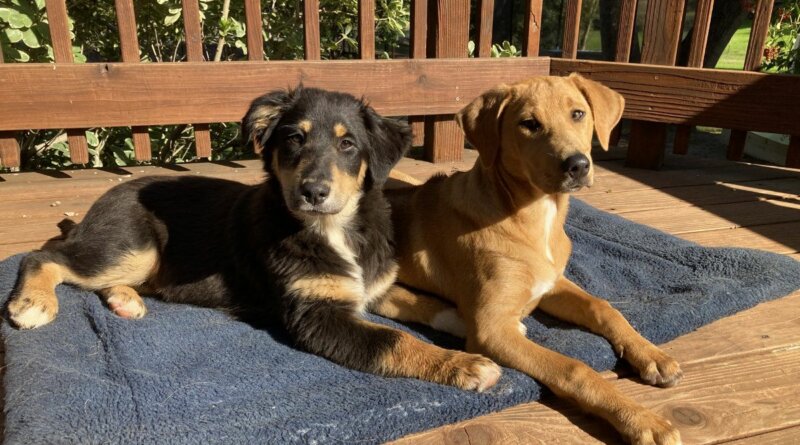Adopting Sibling Puppies – Whole Dog Journal
I have the privilege (and responsibility) of dog-sitting two of the pups from my most recent foster litter – for a whole week! – while their family is on vacation.
How many of you caught the “two pups, one family” thing? If you noticed it (and winced), you’re probably a dog trainer.
Originally, the family was interested in adopting two pups, and I talked them out of this (they are my former in-laws, so we have more of a rapport than in most cases!). Most training professionals try to dissuade people from adopting sibling pups – and insist on a singleton adoption in cases like this, when the family lacks a lot of dog experience. There are numerous reasons for this, but to name a few:
• Sibling pups often bond more firmly and pay more attention to each other than to the human family members.
• House-training (and every other kind of training) often requires twice (or more) of the time that it takes to train one pup.
• Many families lack the time and resources to separate the pups frequently enough that they learn to be confident and social when they are not in the company of their sibling.

There are more reasons to not adopt siblings (and some workarounds, too) in this article by WDJ Training Editor Pat Miller, and I listed all of them to this family. They listened, heard me, and ended up adopting one of the two females in the litter that strongly resembled a purebred Rhodesian Ridgeback. They named her Xena.
But a couple weeks later, the husband’s mom, who lives in the same town as Xena’s family, met Xena and fell in love with her, and then contacted me to inquire about adopting one of the two remaining pups. I ended up driving to the town where both families live, to give the mom a “meet and greet” with the two last puppies, so she and her husband could choose which one suited them best. They ended up falling for the boy pup, and I left him with her and her husband.
I then visited the family who adopted Xena – who was overjoyed to have a chance to play with her last unadopted sibling, whom she hadn’t seen for a couple of weeks.
Over the course of the afternoon that I visited with my former in-laws, they fell in love with the last unadopted puppy, and made a strong and renewed case to be allowed to adopt her, too. I could have just said no – even though the shelter that I was fostering the pups for would have said yes; they don’t have a policy against multiple-pup adoptions. We discussed the pros and cons again, and I reminded them once again about the many accommodations they would need to make to ensure that both pups would end up as well-trained, socially secure pups who could be separated without trauma. They were willing to do the work, they said.
Two things clinched my decision to permit the adoption to go forward:
1. They were doing a great job already with Xena. After just two weeks in their home, she was clearly bonded to the whole family, responding appropriately to her name, nailing a “default sit” whenever anyone made eye contact with her, and still at a healthy weight. I saw lots of dog toys laying around, and a crate in the parents’ bedroom. (I like to see this; it’s the only way to hear the pup who might be fussing in the night because she needs to go potty. People who put their puppy’s crate in some distant room or worse, the garage, end up with dogs who hate their crates and/or learn to just go potty in the crates, since no one could hear or would respond to their cries of distress.)
2. They are in the process of building a new house on a rural property. Frequently, the dad stays in the not-quite-finished house and the mom stays at their old house in a nearby town. This gives them an easy way to easily and frequently separate the pups for a night or day during this critical socialization period.

But, some weeks later, ironically, I feel like I’m the one who has been most inconvenienced by this sibling adoption. While I’m truly happy to be able to spend a week with the pups (I hardly ever get to get my hands on foster puppies of this age; once they get adopted at about 10-week-old mark, I rarely see them again!), now I have to take my own advice and separate them for training and socializing! Especially since, just as I worried, the family is finding it difficult to find the time to take them on separate outings and hold separate training sessions – so I feel I have to do it! And BOY does it take a lot of time!
One thing I should be doing but just don’t have the time to do is to take them on separate walks. I’m already taking my own two dogs on separate walks on certain days! These days, with 14-year-old Otto losing the physical ability to take long walks, I often take just 6-year-old Woody for a drive to our favorite off-leash trails, and then come home and take Otto for his own walk in our rural neighborhood. At this point, he’s content to walk on leash and leave his mark on trees and shrubs along the roadside; we go about a half-mile up the road and then mosey back to our house. In order to get any work done with the puppies here for the week, I need to exercise them to the extent of their energy and fitness level, so I have been taking them out to the off-leash trails with Woody. This is terrific for tiring them out, but it would be better for their social development if they were taking individual outings, not just relying on each other for confidence in new situations.
Did you or someone you know adopt sibling pups? How did it work out? What were the most challenging aspects of the adoption?




